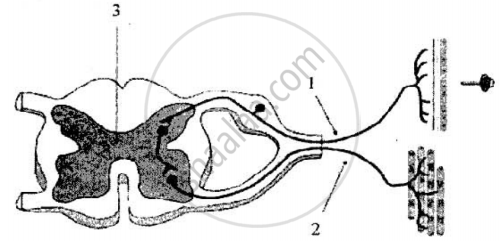Advertisements
Advertisements
Question
State whether the following is
Cleaning
Options
simple reflex
conditioned reflex
None of the above
Solution
Cleaning of table - voluntary action
APPEARS IN
RELATED QUESTIONS
The diagram given below shows the internal structure of a spinal cord depicting a phenomenon. Study the diagram and answer the questions:

1) Name the phenomenon that is depicted in the diagram. Define the phenomenon.
2) Give the technical term for the point of contact between the two nerve cells.
3) Name the parts numbered 1, 2 and 3.
4) How does the arrangement of neurons in the spinal cord differ from that of the brain?
5) Mention two ways by which the spinal cord is protected in our body.
What is spinal cord? What is its main function?
What is a reflex action? Explain with the help of an example.
Which of the following are cerebral reflexes?
(i) a person pulls away his hand on touching a hot object
(ii) a person spits out immediately when a fly enters his mouth while talking
(iii) A person walking bare foot lifts his foot at once on stepping on to a nail
(iv) A person's pupil contracts at once in the presence of bright light
(a) (i) and (ii) (b) (ii) and (iii) (c) (iii) and (iv) (d) (ii) and (iv)
The involuntary actions in the body are controlled by :
(a) medulla in forebrain
(b)medulla in hindbrain
(c) medulla in spinal cord
(d) medulla in midbrain
State whether the following is simple reflex, conditioned reflex or neither of the two.
Contraction of eye pupil
Explain the mechanism of reflex action with the help of a suitable diagram.
List in tabular form three distinguishing features between cerebrum and cerebellum.
What is a reflex action?
The diagram given below shows the internal structure of a spinal cord depicting a phenomenon. Study the diagram and answer the following questions.
 |
- Name the phenomenon shown in the figure and define the same.
- Identify the parts labelled as 1 and 2. Write one functional difference between these two.
- Name the bony protective covering and the membranous protective covering of the spinal cord.
- Label the guidelines 3 and 4.
- How is the labelled part 3 different from part 4 with respect to its composition (part of neuron)?
- Give the technical term for the point of contact between the two nerve cells.
- Name the fluid filled inside the central canal of spinal cord.
- Name the term used for a small gap between two neurons.
- Give one example of a neurotransmitter.
- Draw a neat diagram of a nerve cell and label the parts: Perikaryon, Node of Ranvier, Myelin sheath and Axon terminals.
